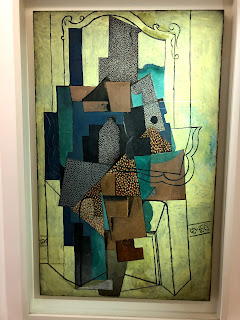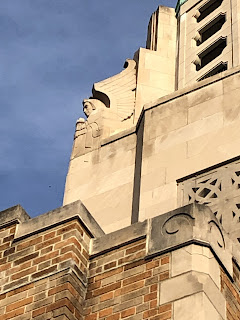Perhaps it's no coincidence that I found myself thinking about these phenomena as I pedaled around the Place des Vosges and through narrow streets lined with sandstone-colored buildings: My morning's meanderings ended at la Musee Picasso.
So how are my ramblings and ruminations connected to the creator of Demoiselles d'Avignon and Guernica?
Well, actually, I started to think about the way we receive sensory details--on or off our bikes--on Saturday, while looking at an exhibit of Cubist painters in the Centre Pompidou. The way Picasso, Braque and others dissected (visually, anyway), faces, objects and vistas, then re-assembling them in new ways, does not reflect the way our eyes see--or, at any rate, the way we are accustomed to thinking that our eyes see. Rather, those artists were showing us how something besides our sensory organs--call it the mind, the intuition or the spirit (I mean that in a secular sense.) senses the world around us--which, of course, cannot be a re-creation of the object, the face or whatever we see.
It makes sense when you realize that the words on this page, or any other words, cannot transmit the things they are supposed to communicate or represent. All they can do is convey something--a code, if you will-- that the mind turns into an image or idea of whatever the words are supposed to convey. The mind doesn't do that simply by taking in the sequence of letters that form the word; it turns them into something that the mind or consciousness, or whatever you want to call it, can use to portray an idea or essence of whatever that word is supposed to represent. If you see the word "house", your mind provides you with an image of a house because it turns the letters of the word into something your mind can re-assemble into a visualization of some house or another.
I am not a neuroscientist, so I have been able to describe our conscious processes only in the language I could find in my own intuition, such as it is. And I know even less about the way computers process data, so please forgive me if what I say next makes less sense than anything I've said before.
Here goes: It occured to me, while riding afterward, that Cubism may well have been a prototype of how computers process data--and, in particular, how information is conveyed through computer systems and, in particular, across the Internet. As I (mis)understand it, what I am typing right now won't be posted directly to my blog: It must be changed into a format that can be sent and re-assembled into the intended message or content. And that format, as I understand it, bears no resemblance (at least in terms of logic or syntax) to the language we use and has to be rearranged in ways we never would (or could) do in order to convey our message.
So..Could the Cubists have been proto-computer scientists?
Anyway, riding is always a great primer for looking at art, or almost anything. And within steps, literally, of the Picasso there are two other museums. I was going to go to the Carnavalet, but it was closed for renovations. So I went to one I visited on my previous trip to Paris: the Cognacq-Jay.
Like the Jacqmart-Andre, it was the residence of a wealthy couple who collected art and objects. The collection was on display, but there was also an interesting exhibit about "l'art du commerce." It shows how artists like Jean-Antonine Watteau were instrumental in bringing about what we might recognize as marketing in the 18th Century.
The convergence of a few factors made it possible. One was, ahem, colonialism, which gave France and the rest of Europe access to a wider variety of materials--and designs they'd never before seen. Another was the means to reproduce the exotic objects that came from afar, mainly the Middle and Far East. Then there was the development of merchant and middle classes --whose tastes and demands drove these new markets--and, last but not least, a group of artists and other creative people.
This is the era in which, essentially, department stores and catalogues began. That is why artists like Watteau others of his generation were so suited for this development: They had sketch-like techniques developed for creating portraits of merchants, bankers and other professionals: the sorts of people (and their families) to whom marketing was directed. So, in some weird way, you can thank (or blame) Watteau for Amazon--or, if you're of my generation, Bike Nashbar, Performance, Supergo and all of those mail-order shops that sold all of those exotic and unaffordable bikes and parts we couldn't find at our neighborhood Schwinn dealers.
Could it be that the bicycle developed from the draisienne to what we ride today because of the l'art du commerce?












































